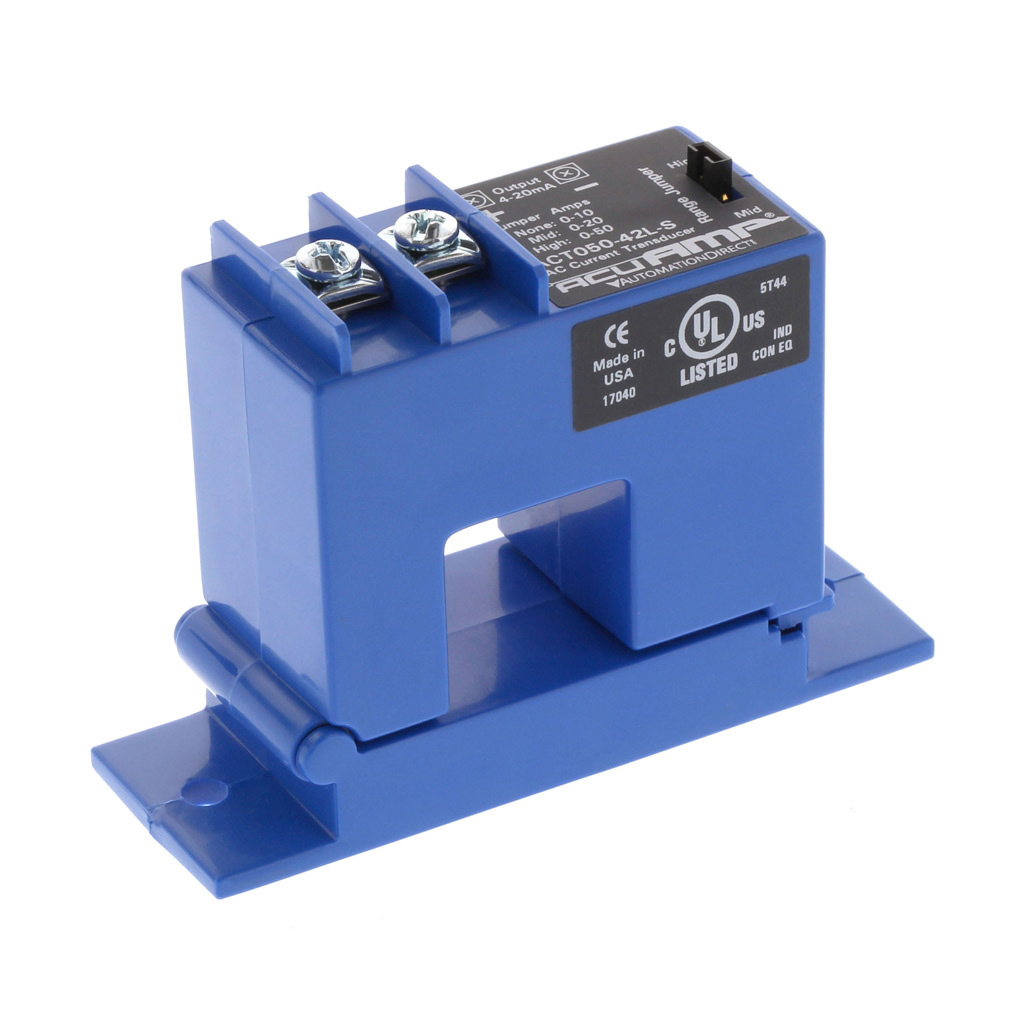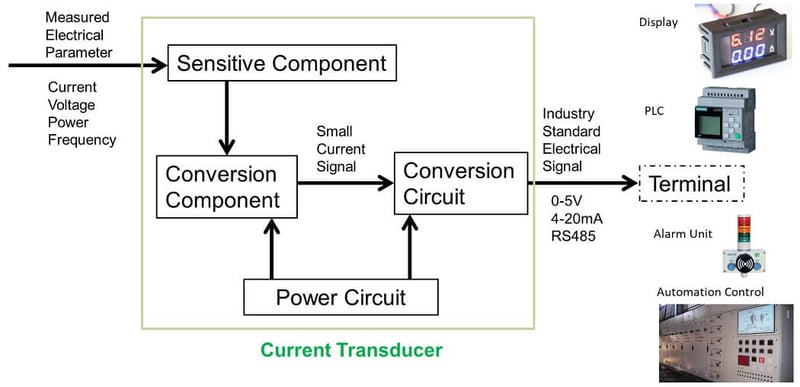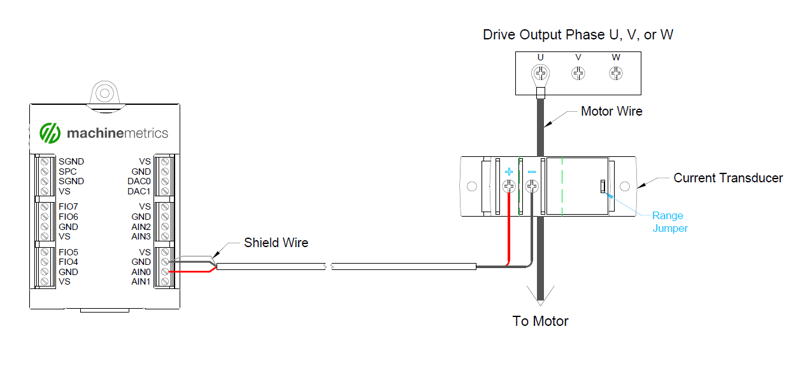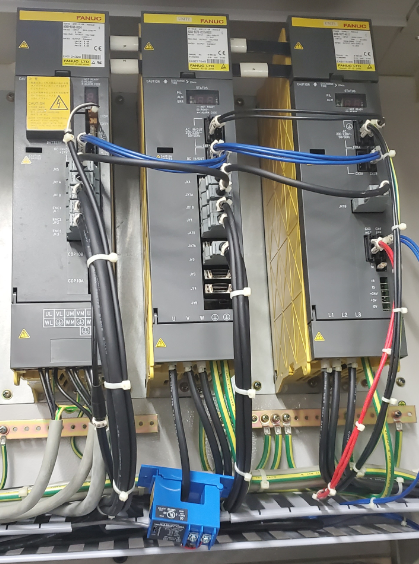Current Transducers
Sensors are everywhere in manufacturing. They record temperature, vibration, and other critical data in industrial environments. Some are simple devices that record and forward a condition. Many require the additional capabilities of transforming data.
Current transducers monitor the non-sinusoidal waveforms of a conductor and output DC voltage. They can be especially helpful in collecting utilization data from legacy equipment.

Current Transducers: Capturing Utilization in Legacy Machines
What is a Current Transducer?
Current transducers convert physical activity to electrical activity to measure force, temperature, pressure, or another variable. They can send data to a cloud-based machine data platform and trigger independent action via an actuator when the sensor detects physical properties that require it.
A current transducer provides DCs or volts proportionately from an AC input current, which is done by monitoring the AC on conductors. The transducer will output a DC proportional to the AC when detected.
One example of a transducer deployed is in machinery with spindle or axis drives. This is often found in CNC machining. Here, the transducer converts voltage to determine a machine's active and idle status.
Other applications include:
- Temperature
- Speed
- Ramp speed
- Pressure
- Humidity
- Force
- Proximity
- Infrared sensing
- Level sensing
How Do Current Transducers Work?
Current transducers have a sensing element and a transduction element. The sensing element is the part of the transducer that detects the physical condition or activity of the machine.
The transduction element is where the physical trigger is converted into an electrical signal. The transducer converts energy proportionally based on the scope of physical activity, like start or stop or open or closed. This allows the current to be read by a meter or other measuring apparatus and indicate the machine's status.
 Image Source: Set Transducer
Image Source: Set Transducer
What are the Different Types of Transducers?
There are two basic types of transducers. The first is the input transducer, which converts physical energy or environmental changes into a signal. These signals are readable by embedded machine software or HMIs. They enable operators and managers to understand physical activity and whether or not attention is needed.
The second type is an output transducer. Output transducers, often called actuators, are the opposite of input transducers. They use electric signals to trigger another form of energy somewhere within the machine or system. For example, if the temperature of a moving part is too high, a signal is sent through the transducer to trigger the motor of a cooling fan or a light to alert an operator.
How is a Transducer Different from a Sensor?
A sensor is a type of transducer but is more straightforward in its application. It may measure only pressure or motion and signal that something is or isn’t occurring. The electrical signals generated by the sensor are sent to another location like a machine display, computer, or machine data platform for standardization, storage, and analysis.
Transducers have more flexible capabilities in that they have sensors and actuators embedded. In a current transducer, the sensor reads the condition while the actuator, based on programming or another incoming signal from a controlling apparatus, triggers a response at the machine or spindle level.
How Are Transducers Added to Automation Solutions?
Modern OEM equipment will usually have interconnectivity built in. But since digitization has only accelerated in the last few years, a lot of existing equipment has either siloed capability or no native capability for connection.
To enhance a machine's capabilities for automation, the current transducer must be attached to a machine's existing I/O modules. Advanced machine data platforms like MachineMetrics have adapter kits for legacy equipment.

Most manufacturers have a wide range of OEM machines and different models and vintages of equipment. A solution must be flexible enough to merge native OEM assets and legacy (and often analog) equipment.
Once the current transducer is connected to the correct I/O terminals for that application, adapter scripts and other tools ensure that variables like run/idle state can be determined using voltage readings.
Advanced systems like MachineMetrics rely on the I/O module to facilitate the inputs and outputs needed to gather machine data. This is a highly flexible system of capabilities that can work from Ethernet, USB, or even wirelessly.
Once the I/O installation is done, the machine can be networked with the MachineMetrics Machine Data Platform. The parameters can then be configured to forward captured data to the cloud-based platform for analysis.

A current transducer connected to a spindle drive.
Using a Machine Data Platform for Managing and Analyzing Machine Status
IIoT sensors and current transducers are critical components of a connected factory. A cloud-based platform is an ideal repository for data and the best way to gain insights that humans would miss. Inside these advanced platforms, data is cleansed, standardized, and analyzed to generate real-time actionable insights.
This process happens at an extremely high speed and employs signal conditioning to enhance data quality. With the right analytics platform, noise can be filtered, micro-voltages can be amplified, and vibration effects can be mitigated.
Employing sensors and current transducers along with direct machine connections ensures accurate, real-time, standardized data across all equipment, both modern and legacy.
Ensuring Connectivity to All Sensors and Transducers
MachineMetrics is the leading platform to collect, monitor, analyze, and drive action with manufacturing equipment data. Our platform easily captures data from your manufacturing equipment and provides a complete toolkit to drive actionable insights for frontline workers and other factory floor systems that improve the efficiency and quality of production.
Whether modern equipment, legacy asset, or simply an environmental condition, you can easily connect and collect data across all your machines, sensors, and devices for complete operational visibility.
Want to see the platform in action? Book a Demo Today.